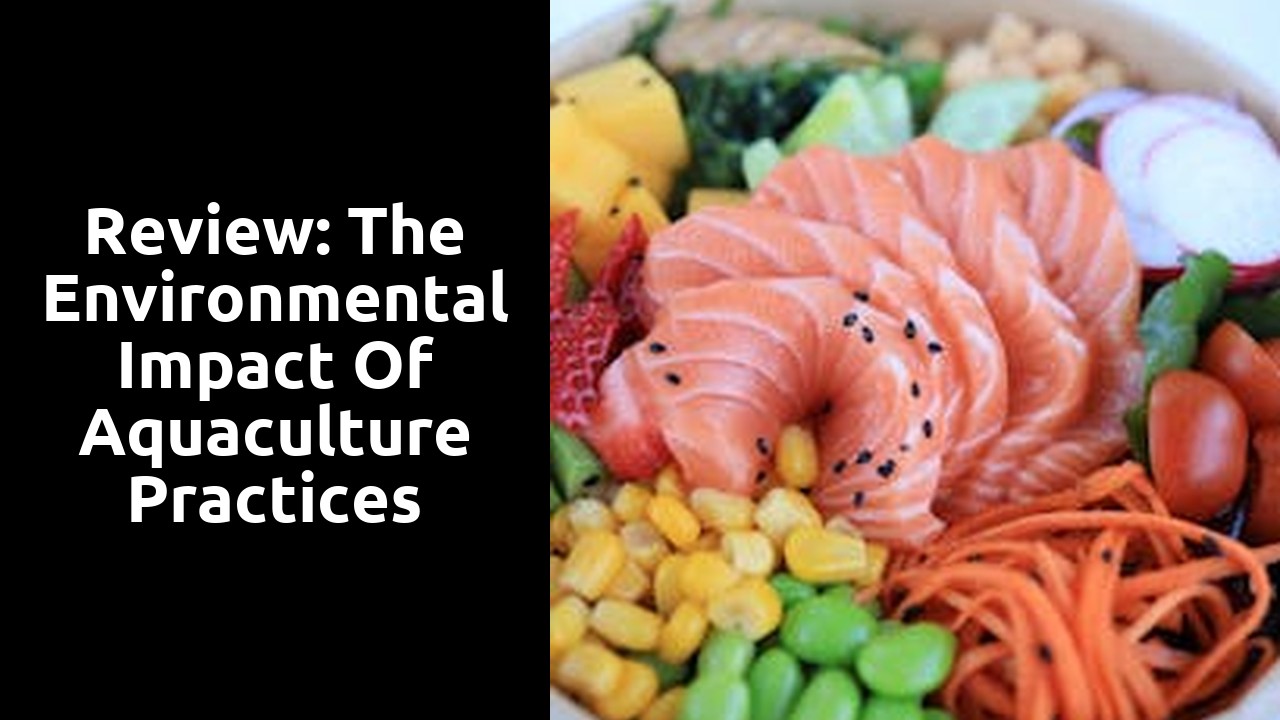Review: The Environmental Impact of Aquaculture Practices

Health Concerns Related to Aquaculture Practices
Aquaculture practices pose significant health concerns that warrant close attention in the industry. One of the key issues is the rampant use of antibiotics to prevent and treat disease outbreaks in fish farms. This excessive use of antibiotics can lead to the development of antibiotic-resistant pathogens, which not only affect the farmed fish but also pose a risk to human health if these pathogens enter the food chain. Furthermore, the use of chemicals and pesticides to control parasites and algae in aquaculture facilities can have detrimental effects on the surrounding ecosystems and biodiversity.
In addition to the concerns surrounding antibiotic use and chemical pollution, the overcrowding of fish in aquaculture facilities can also lead to the rapid spread of diseases. The close proximity of fish in these facilities provides an ideal environment for pathogens to thrive and spread quickly among the population. Disease outbreaks not only pose a threat to the welfare of the farmed fish but can also result in economic losses for aquaculture businesses. It is essential for aquaculture practices to adopt more sustainable and environmentally friendly approaches to mitigate these health risks and ensure the long-term viability of the industry.
Monitoring and Managing Disease Outbreaks in Aquaculture Facilities
Diseases pose a significant threat to aquaculture operations, impacting both the environment and economic sustainability. To effectively manage disease outbreaks, aquaculturists must employ stringent monitoring protocols and rapid response strategies. Regular health assessments of fish stocks, water quality testing, and the implementation of biosecurity measures are imperative in preventing the spread of diseases within aquaculture facilities. Early detection is crucial in containing outbreaks and minimising their impact on both farmed fish populations and surrounding ecosystems.
Furthermore, the use of vaccines and probiotics has shown promise in enhancing the immune response of farmed fish, reducing the incidence of diseases in aquaculture settings. Proactive collaboration between industry stakeholders, researchers, and regulatory bodies is essential in developing effective disease management strategies. By incorporating a holistic approach to disease prevention and control, aquaculture facilities can mitigate the environmental risks associated with disease outbreaks and ensure the long-term sustainability of the industry.
Regulatory Frameworks for Sustainable Aquaculture
Legislation plays a pivotal role in ensuring the sustainability of aquaculture practices. In the United Kingdom, the government has implemented a robust regulatory framework to oversee the operations of aquaculture facilities. This framework encompasses various aspects, including environmental protection, animal welfare, and food safety standards. By adhering to these regulations, aquaculture operators are required to mitigate their environmental impact, maintain high hygiene standards, and ensure the well-being of the aquatic organisms under their care.
Moreover, regulatory bodies conduct regular inspections and audits to monitor compliance with these standards. Non-compliance can result in fines, license revocation, or even closure of the aquaculture facility. Therefore, these regulations act as a deterrent against irresponsible practices that could harm the surrounding ecosystems and jeopardize the sustainability of the aquaculture industry. Through stringent oversight and enforcement, the UK government aims to foster a culture of environmental responsibility and ethical conduct within the aquaculture sector.
Analysis of Government Policies on Aquaculture Sustainability
Government policies play a pivotal role in shaping the sustainability of aquaculture practices. In the UK, the government has implemented stringent regulations to ensure the responsible management of aquaculture operations. These policies encompass various aspects such as water quality monitoring, disease prevention measures, and ecosystem conservation to mitigate the environmental impact of aquaculture activities.
Moreover, the UK government has actively engaged with stakeholders in the aquaculture industry to develop policies that foster innovation and sustainable practices. By working closely with industry experts, policymakers can better understand the challenges faced by aquaculture operators and tailor regulations to address specific concerns. This collaborative approach not only promotes environmental protection but also supports the growth and viability of the aquaculture sector in the long term.
Technological Innovations in Aquaculture Industry
Technological advancements have played a pivotal role in revolutionising the aquaculture industry, with innovations designed to enhance efficiency and sustainability. One notable development is the use of Automated Feeders, which dispense precise amounts of feed at optimal times, reducing waste and preventing excess nutrients from polluting water bodies. These devices not only improve feeding practices but also minimise the environmental impact of aquaculture operations.
Additionally, the integration of Water Quality Sensors has become commonplace in modern aquaculture facilities. These sensors continuously monitor crucial parameters such as oxygen levels, temperature, and pH, allowing for real-time adjustments to maintain optimal conditions for aquatic species. By ensuring water quality parameters are within the desired range, aquaculturists can mitigate the risk of disease outbreaks and improve overall production efficiency.
Advancements in Aquaculture Practices for Environmental Conservation
Advancements in aquaculture practices have been pivotal for promoting environmental conservation in the industry. One notable development is the use of recirculating aquaculture systems (RAS), which help in reducing water usage and minimizing the discharge of pollutants into surrounding ecosystems. By efficiently filtering and reusing water within closed systems, RAS not only conserves resources but also decreases the environmental impact of aquaculture operations.
Another key advancement lies in the implementation of integrated multi-trophic aquaculture (IMTA) systems, which involve the cultivation of multiple species in proximity to create a symbiotic relationship. For instance, the waste produced by one species can serve as nutrients for another, leading to a more sustainable and eco-friendly approach to aquaculture. IMTA systems aim to mimic natural ecosystems, thereby reducing the reliance on external inputs such as feed and limiting the release of harmful by-products into the environment.
Related Links
The History of Overfishing and Depletion of Wild Salmon StocksWhat Makes Wild Salmon Sustainable
Why Consumer Awareness is Key to Sustainable Seafood Choices
Top 10 Sustainable Seafood Choices for Consumers
What to Look for in Sustainable Seafood Certifications
Why Overfishing is a Threat to Wild Salmon Stocks